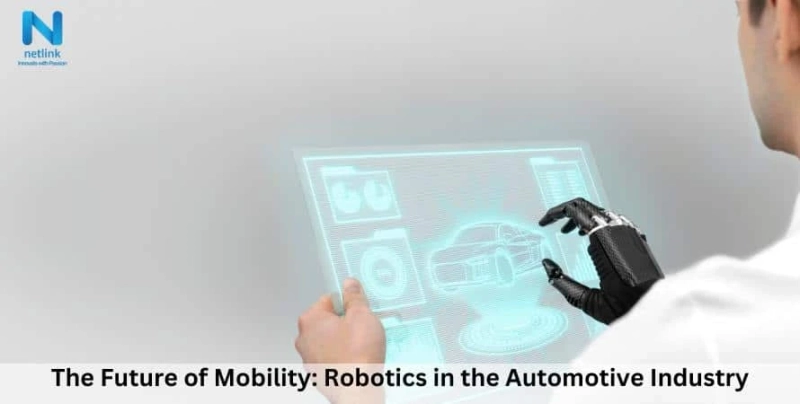A new era of innovation is coming to mobility. In order to investigate the complex changes that could drastically alter the sector by 2035, we looked at regional trends around the globe.
Robotics is poised to play a big part in the Automotive Industry as the Future of Mobility quickly develops. Robotics offers a level of accuracy and efficiency that is unparalleled by even the most expert human employees since they can automate many of the traditionally manual activities, such as welding, and painting. In addition to saving time and money, doing this produces a better-quality product that is more dependable and consistent. Robotics will play a bigger role in the manufacturing process as demand for electric and autonomous automobiles increases. The automobile industry has already started to embrace this future, and in the upcoming years, we can anticipate even more innovation and breakthroughs.
Mobility is one of the hottest industries right now, where traditional OEMs and start-ups are constantly creating new technologies and modes of transportation. However, despite the influx of creative solutions, the issue of congested roads has not yet been resolved, and its effects are being felt in almost every nation. In Los Angeles, wasted time in traffic reached 119 hours prior to the pandemic, when roads were more congested; drivers in Munich waste an average of 87 hours per year in traffic.
in 2035,
The new world of AutoTech combines ride-hailing, self-driving cars, and electric vehicles to create a thriving new economy. The global vehicle industry could be completely changed by this new amalgamation, which is connected to digital networks and a tonne of incredible technology!
The competitive positions of automotive OEMs will be put to the test by newly empowered market participants, including suppliers, on-demand platforms, digital behemoths, and cities with a strong focus on mobility.
Additionally, I see a longer lifetime of consumers who are more informed and more transparent in the future. Information will guide consumer decisions rather than marketing. The majority of driving tasks will soon be handled by the car thanks to technological advancements. Although managing laws and regulations are getting more challenging.
Disruptive technologies and trends are transforming mobility
Here is a look at the disruptive trends and technologies that will affect mobility globally and help shape it in the future.
The new options are exciting to the public
An annual consumer survey is conducted by the McKinsey Centre for Future Mobility and examines four key trends: shared mobility, connectivity, electrification, and autonomous driving. Many of the people who responded to the 2022 survey say they are willing to change how they commute. Take a look at some findings.
- Over the next ten years, 30% of respondents intend to use micro-mobility (like e-bikes and e-scooters) or shared mobility more frequently.
- In the next ten years, nearly half of the respondents (46%) are willing to give up their personal vehicles in favor of other forms of transportation.
- 70 percent of respondents are open to riding in a shared autonomous shuttle with up to three other passengers; otherwise, 42 percent of those trips would be made in a private vehicle.
Many of these changes are motivated by the desire for a more pleasurable mobility experience. Cities that can provide that convenience may see an increase in metro ridership. A quick trip on the tube while reading a book frequently beats an hour in traffic. Sustainability issues are also very important. According to the survey findings, 46% of respondents have already shifted to more environmentally friendly brands or products, and another 16% intend to make significant changes to support sustainability.
Regulations promote sustainability and awareness
Around 20% of the world\'s greenhouse gas emissions in 2020 came from the transport sector, with private cars contributing more than 40% of the total. More than 150 cities have put policies in place to discourage the use of private vehicles, including initiatives to raise public awareness of the emissions produced by these vehicles, restrict the availability of private vehicles in urban areas, or offer financial incentives for using more environmentally friendly transportation options.
The emergence of new trends and technologies
New automotive and mobility trends, particularly those involving cutting-edge electric vehicle (EV) batteries, frequently make the news. While some might not have their full impact for a number of years, others are developing more covertly and could have an equally significant impact on future mobility.
(AVs) Autonomous Vehicles
By 2025, level three and level four automation features will be more prevalent in passenger vehicles in Europe and North America, making them highly automated or capable of self-driving on highways. Given their large potential customer bases, major cities like Beijing, London, and New York could develop into the top markets for shared autonomous vehicles.
Rise of micro-mobility
Currently, the value of the global micro-mobility market is about $180 billion. According to a McKinsey analysis, the value could more than double by 2030 and reach $440 billion.
Intermodal application development
Multiple modes of transportation are used in intermodal journeys. Travelers can now more easily plan their trips thanks to platforms that integrate all feasible mobility combinations for a specific route. Jelbi, for instance, displays potential routes involving different modes of transport along with their duration and cost.
Moving forward with shared or pooled zero-emission vehicles
As more people search for convenient, affordable, and sustainable transportation options, shared mobility (including ride-hailing) is growing. By 2030, this market could bring in up to $1 trillion in revenue.
Use Netlink\'s business-specific mobility solutions to manage your business while you\'re on the go. Our knowledgeable teams handle usability monitoring, reporting, navigational simplicity, and control. You can better manage your business, respond to customer needs more quickly, and increase team productivity with round-the-clock insights. So what are you waiting for? Join us and grow your business with us.
Mobile applications are now a necessity for businesses and a way of life. You must decide even while moving in a faster world. With Netlink\'s Enterprise Mobility solutions, you can make decisions more quickly while on the move.
By transforming processes, streamlining operations, improving customer engagement capabilities, and employing a high level of intelligence, you can unleash the power of mobility for your company.
With the aid of Netlink\'s mobility solutions, your company can expand more quickly, steadily, and shrewdly. The mobile-first strategy not only puts you ahead of the competition but also improves your company\'s operations with robust analytics while streamlining processes and increasing productivity and customer engagement.
Conclusion
It is impossible to overlook how robotics will affect the automobile sector. We may anticipate a radical shift in how we design, operate, and repair cars as a result of the integration of cutting-edge robotics and AI technologies. We are in the midst of an exciting transformation that will increase comfort and safety as well as production and efficiency. Robotics represents the untold potential for innovation and growth in the automotive sector, and we are eager to see what the future will bring. As we embrace this dramatic change towards a more automated automobile sector, fasten your seatbelt and get ready for an exciting ride.




